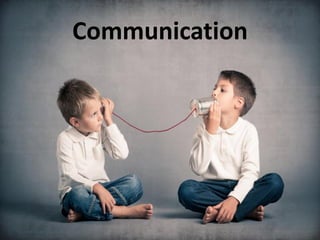
Communication
- 2. We Communicate@Work to Inform & Instruct Share information Motivate Employees Manage workplace Lead the Organization
- 3. Improper Communication@Work Source of maximum problems, Creates misunderstanding, Increases blame game, Diminishes the trust, Destroys creativity, Affects the working environment badly, Destroys motivation, Reduces the productivity, Creates chaos at workplace, Ultimately it ruins everything.
- 4. Communication A process to share Information, Ideas, Thoughts, Emotion, Feelings to self or others. Levels of Communication: Intrapersonal, Interpersonal (Face to Face), Group (Small Group Discussion), Lecture/Public Specking, Mass Media Communication, Intercultural. Types of communication: Verbal & Nonverbal
- 5. Verbal Communication Oral: Spoken words are used. Influenced by pitch, volume, speed & clarity of speaking. Quick feedback. Facial expression & body language to guess the authenticity of the message. Less chance to think deeply. face-to-face conversations, speech, telephonic conversation, video, television, radio, voice over internet.
- 6. Verbal Communication Written: Written signs or symbols are used. Possible to edit and revise, keep record and backup. It enables receiver to fully understand it and send appropriate feedback. It doesn’t bring instant feedback. Number of people struggles for writing ability. Mostly used in various organizations (Email, letter, report, memo etc.).
- 7. Nonverbal Communication Wordless messages. Body language, eye contact, gesture, posture, touch, tone of voice, clothing, hairstyle, neatness, use of cosmetics, space, lighting, decorations, furnishings, facial expressions even silence. 93% of our total communication is Nonverbal.
- 8. Importance of Non-Verbal Communication Nonverbal communication is 93%
- 9. Effect of Distance on Communication Intimate 0 to 1.5 Feet. Only for loved one’s. Family, Wife, Child, pet animal. Personal 1.5 to 4 Feet Distance required to shake hands. Friends, Personal or Secret Discussion. Social 4 to 12 Feet. Distance required to keep eye contact or you feel free to talk. Stranger, Customer, Collogue, Someone you do not know closely. Mass 12 Feet or more. Classroom, Park, Speech. Nonverbal Communication plays important role.
- 11. Barriers in Communication Lack of Attention Lack of Education Physical Barriers Distance Proper Timing Lack of Proper Direction Lack of Proper Plan Wrong Concept Wrong Anticipation Mixed Message Word with various meaning Words use in specific group Excessive Information Use of Dialect Cultural Difference Social Difference Gender Difference Rumor / Gossip Generation Gap Personal Thought/ Idea Viewpoint/Mentality Hearing Impaired Edited Information New Technology Emotion Fear of criticism Offensive Mindset Defensive Mindset
- 12. Norman Rockwell (1884 – 1978) American author, painter & illustrator
- 13. Successful Communication: Sender Think before delivering a message, its like an arrow free from a bow, you can’t make it return. Organized Message Be Respectful Talk Normally Take Time No Wrong Message Avoid Wrong Concept Use Proper Words Proper Body Language Don’t be Offensive Don’t be Scared Keep Eye Contact Maintain Proper Tone Try to Avoid Dialect Use Proper Channel Maintain Proper Distance Timing Learn to Use ‘YES’ & ‘NO’ Proper Use of Emotion
- 14. Successful Communication: Receiver Pay Attention Listen Carefully Do not Interrupt Don’t be Defensive Proper Use of Emotion Maintain Proper Body Language
- 15. Successful Communication: Organization Simple Organizational Structure Understandable Target Remove Noise Barrier Provide Info/Update Use of Proper Channel Clear Job Description Arrange Training Transparent Accountability Encourage Feedback
- 16. Let's Wipe the Barrier to Communicate!
- 17. No More Blah Blah Blah, Let’s Communicate Effectively!!!